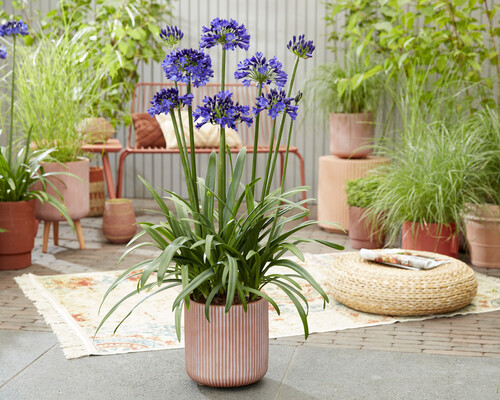Expanding Agapanthus: A Complete Guide to Beautiful Blooms
Expanding Agapanthus: A Complete Guide to Beautiful Blooms
Blog Article
Grasping the Art of Agapanthus Care: Crucial Actions for Healthy And Balanced Development and Vibrant Blooms
In the world of gardening, the growing of agapanthus stands as a fulfilling undertaking for those that seek to nurture these stylish blooming plants. With their striking blooms and elegant foliage, agapanthus has actually recorded the interest of garden enthusiasts worldwide. Nonetheless, attaining ideal development and lively blooms needs a nuanced strategy that includes different important actions. From picking the ideal range to grasping pruning methods, the journey towards growing flourishing agapanthus plants is multifaceted and holds the key to opening the complete capacity of these organic treasures.

Picking the Right Agapanthus Selection

When choosing the appropriate Agapanthus variety for your yard, consider aspects such as climate suitability, flower color, and development practice. In addition, think about the environment in your area to ensure the Agapanthus variety you choose can prosper in your particular problems. Comprehending the growth behavior of different Agapanthus varieties is crucial for appropriate placement within your yard.
Perfect Planting Problems
Taking into consideration the ideal ecological requirements is crucial for successful Agapanthus growing. Agapanthus plants are sensitive to cool temperatures and must be secured from frost throughout wintertime months.
To guarantee healthy growth and vibrant blooms, plant Agapanthus bulbs at a depth of regarding 2-4 inches and space them 8-12 inches apart. Including raw material, such as garden compost, to the soil can enhance drainage and fertility, promoting robust origin development. Mulching around the base of the plants helps retain moisture and subdues weed development. Normal watering is vital, specifically throughout the growing period, to maintain the soil regularly wet yet not saturated.
Watering and Feeding Tips
Maintaining appropriate moisture degrees and providing essential nutrients are crucial elements in the care program for Agapanthus plants. It is important to strike a balance when it comes to watering Agapanthus. If overwatered, these plants prefer consistently moist dirt however are prone to root rot. During the expanding period, water deeply as soon as a week, making sure the soil is well-draining to stop waterlogging. In hotter environments or during durations of dry spell, more constant watering may be necessary to maintain the dirt uniformly moist. However, lower watering in the wintertime to avoid water logged problems.
Fertilizing Agapanthus is crucial for promoting healthy growth and prolific blooms. Apply a well balanced plant food, such as a 10-10-10 formula, in the early spring as new growth arises. Repeat this application every 6-8 weeks throughout the expanding season. Stay clear of excessive fertilizing, as it can cause lush foliage at the expense of blooms. Always comply with the supplier's guidelines for proper dilution and application methods. By complying with these more information watering and fertilizing ideas, you can ensure your Agapanthus plants flourish and create vivid, resilient flowers.
Trimming Strategies for Agapanthus
Pruning Agapanthus plants at the ideal times and with proper strategies is vital for preserving their health and wellness and advertising optimal growth and blooming. The perfect time to trim Agapanthus is in late winter season or early springtime before brand-new development arises.
For flowered stems, wait till the flowers have actually perished more and after that cut them back to the base. This not only cleans up the plant's appearance however also urges the development of new flower buds. Deadheading spent flowers can additionally reroute the plant's power into creating more blossoms rather than establishing seeds. Nonetheless, if you wish to collect seeds for propagation, leave some flowers to dry and fully grown on the plant.
Remember to utilize tidy, sharp tools to make accurate cuts and decrease the threat of introducing conditions. Agapanthus. Routine trimming will aid maintain your Agapanthus looking cool and healthy while making certain an abundant screen of stunning blossoms
Handling Common Pests and Illness
After making certain proper trimming methods for Agapanthus, it is necessary to deal with common insects and illness that can impact the health and vigor of these plants. Agapanthus plants are usually durable however can still come down with specific concerns. One usual pest that impacts Agapanthus is the Agapanthus gall midge. This small, orange fly lays its eggs in the foliage, causing altered growth and blossom buds that stop working to open. To battle this pest, trim and ruin any Home Page kind of damaged plant parts and consider making use of insecticidal soap.
Additionally, Agapanthus plants can suffer from root rot if they are grown in improperly draining soil. By being vigilant and taking timely activity against conditions and parasites, you can aid your Agapanthus plants flourish and produce vivid blooms. Agapanthus.

Verdict
Finally, understanding the art of agapanthus treatment includes selecting the appropriate range, offering perfect growing conditions, appropriate watering and fertilizing, appropriate trimming methods, and resolving usual bugs and illness. By complying with these necessary actions, you can make certain healthy development and dynamic blossoms for your agapanthus plants. Remember to routinely keep an eye on and preserve your plants to promote their overall well-being and long life.
To guarantee healthy development and vivid blooms, plant Agapanthus bulbs at a deepness of regarding 2-4 inches and room them 8-12 inches apart. By complying with these watering and feeding tips, you can guarantee your Agapanthus plants thrive and generate lively, resilient flowers.
One typical insect that impacts Agapanthus is the Agapanthus gall midge. Furthermore, Agapanthus plants can endure from origin rot if they are planted in poorly draining pipes dirt. By adhering to these essential actions, you can make sure healthy growth and dynamic blossoms for your agapanthus plants.
Report this page